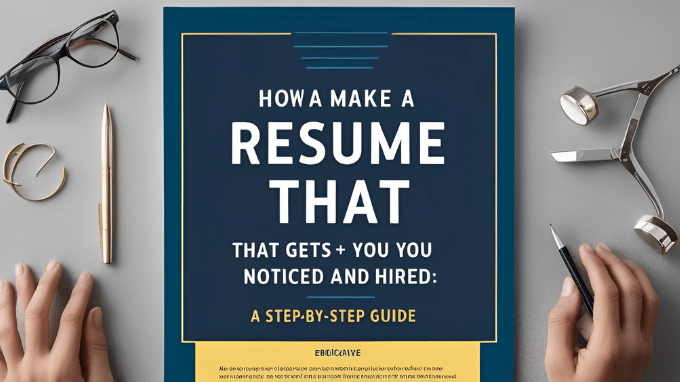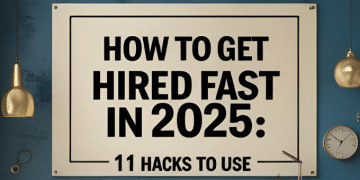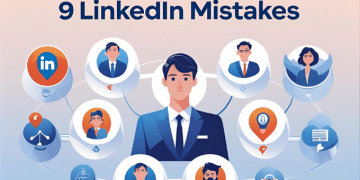How To Make A Resume That Gets You Noticed And Hired: A Step-By-Step Guide

Did you know that recruiters normally scan resumes in just seven seconds before deciding whether they will go on the “yes” or “no” pile? That’s why every word choice, bullet point, and formatting choice matters more than you might think as you browse through numerous job listings.

The short answer is that a strong resume emphasizes accomplishments with measurable outcomes, is clear, and is optimized for keywords.
Every word choice, bullet point, and formatting choice matters more than you might think. Your resume serves as your marketing campaign in the cutthroat job market of today.
The good news is that fancy designs and a list of all your prior jobs are not necessary for a strong resume. The most important thing is to draft a document that accomplishes three important goals:
- Passes through the Applicant Tracking System (ATS).
- Catches the eye during the initial glance
- Compels the recruiter to look over your qualifications more thoroughly.
Read next: Complete Guide to H1B Visas: Requirements, Process, and Cost
The Golden Rule of Resume Writing
Your resume is not an autobiography. Consider it a well-planned highlight reel with the sole goal of landing an interview. Your entire approach to resume writing is altered by this basic change in perspective.
Think about it: Microsoft usually receives about 250 applications for each mid-level position. They aren’t reading at that volume; instead, they are looking for reasons to say “no.” Your task is to eliminate all of those excuses and provide them with compelling arguments for saying “yes.”
With that, keep in mind to eliminate any details that don’t advance that goal.
Key Elements Of A Resume To Beat ATS
1. Key Essentials Of A Resume
Before we dive into strategy application tips, let’s cover the foundational elements—the resume equivalent of showing up to an interview dressed appropriately. Missing these will get your application rejected, regardless of your qualifications.
Formatting That Works:
Clean, professional formatting
Keep excessive colors to a minimum and steer clear of intricate designs unless you work in a creative field. Unless you are a senior executive with a lot of experience, your resume should not be more than one page long. For a neat, polished appearance, use standard fonts in sizes 11 to 12, such as Arial, Calibri, or Helvetica.
Clear contact information
A professional email address like [email protected], a LinkedIn profile with a unique URL, your phone number, your city and state, and your name should all be prominently displayed at the top..
Concise content
Employers will inquire if references are needed, so avoid using statements like “References available upon request.” If you are not in the United States, do not include personal information like your age or photo.
2. The Work Experience Section: Showcasing Your Impact
This is the most important section of your resume, and it’s also where a lot of applicants make mistakes.
The most significant error? listing duties rather than accomplishments from the job, especially in popular industries where the tasks may be repetitive.
The difference is as follows:
Weak: “Oversaw accounts on social media.”
Strong: “Increased Instagram following by 137% in just six months through a targeted Reels strategy, which resulted in a 30% increase in website traffic.”
The second version demonstrates quantifiable outcomes, which is precisely what hiring managers are looking for.
How to highlight your strongest points:
- Use the CAR method (Challenge, Action, Result);
- Challenge: What problem existed?
- Action: What steps did you take?
- Result: What was the outcome?
- Begin with strong action verbs (e.g., Led, Optimized, Spearheaded, Increased, Reduced).
- Tailor your bullets to the job description. If the role emphasizes “project management,” highlight your leadership in cross-functional initiatives.
3. The Skills Section: Be Specific
This is how a generic skills section appears:
Ineffective: “communication skills, Microsoft Office, teamwork, and hard work.”
Recruiters don’t learn anything special about you from this.
Instead, concentrate on job-related hard skills and tools:
Effective: “Google Ads, Salesforce CRM, SEO (Ahrefs, SEMrush), and Python (Pandas, NumPy).”
If the job posting calls for a particular tool or skill that you are familiar with, use exactly the same wording (more on this later).
4. Education & Certifications: Keep It Relevant
Experienced professionals usually move education below experience, while recent graduates should lead with education.
This is how to maximize:
For Recent Graduates:
“B.S. in Computer Science | University of Washington | 2023
Relevant Coursework: Data Structures, Machine Learning, Database Systems
Capstone Project: Developed AI chatbot that reduced customer service response time by 65%”
For Experienced Professionals:
“M.B.A. | Harvard Business School | 2015
B.A. in Economics | Stanford University | 2010
Certifications: PMP (Project Management Professional), Google Analytics Certified”
Read next: How to Negotiate Your Salary Effectively
How to Optimize for Applicant Tracking Systems (ATS)
Before they are ever seen by a human, about 75% of resumes are rejected. Why? Because a software known as Applicant Tracking Systems (ATS) looks for keywords in resumes before sending them to recruiters.
1. Beating the Applicant Tracking Systems (ATS)
The sad truth is that the ATS filters prevent 75% of resumes from ever reaching the eyes of recruiters.
Here’s how to get past this blockage:
Keyword Optimization:
- Pick 5-10 striking keywords from the job description
- Seamlessly include them in your resume
- Add complete terms as well as acronyms; for example, you may write “SEO (Search Engine Optimization”
ATS-Friendly Formatting:
- Steer clear of headers and footers because they are incompatible with many systems.
- Instead of using imaginative titles for your sections, use standard, unambiguous headings like “Work Experience”.
- To guarantee readability, omit pictures and graphics.
2. The 7-Second Test: What Recruiters Actually See
Eye-tracking studies reveal that recruiters focus on key details first:
- Current or most recent job, including company name, title, and dates
- Previous positions and accomplishments
- Education, extracurricular activities, and certifications
- Soft and hard skills
Make sure these elements stand out and are easy to find at a glance.
3. Customization Is Key
Successful job seekers maintain a “master resume” that includes all of their experience, and they customize it for every application. How to personalize yours:
The tailoring process:
- Emphasize the essential qualifications in the job description on paper.
- Check to see if your experience meets their needs.
- Change the wording to match the posting’s language.
Read next: Top Industries That Are Always Hiring in the U.S.
Final Checks Before Submitting
- Carefully proofread it before reading it out loud because silent reading frequently overlooks mistakes.
- Unless otherwise noted in the job posting, save as a PDF.
- Give your file a professional name, such as FirstName_LastName_Resume.pdf, rather than “Resume_Draft_2024_Final.docx.”
- Ask for feedback from a reliable coworker or use Grammarly or another tool to identify errors.
Putting It All Together
Examine how these techniques can result in a true resume makeover.
Before:
“Oversaw a group of sales representatives.”
“Resolved client grievances.”
“Reached sales goals.”
After:
“Oversaw a 12-person sales team that exceeded quarterly goals by 15–22% for five straight quarters.”
“40% fewer complaints were filed after a customer service training program was put in place.”
“Acknowledged as a Top Performer in 2022 and 2023 (out of 65 associates).”
This version demonstrates recognition, accomplishment, and scope—exactly what hiring managers are looking for.
Your Action Plan

- Examine your current resume in comparison to these recommended practices.
- Choose two or three important changes that should be made immediately.
- Create your master resume by including all of your relevant experience.
- To customize apps, develop a tailoring system.
A resume is a dynamic document. Add new accomplishments, abilities, and experiences on a quarterly basis, even if you’re not actively looking for a job.
Here is a simplified, step-by-step guide to assist you:
Step 1: Content Audit
- Emphasize each measurable outcome on your present resume.
- To match your experience with three target job descriptions, pick one.
- Create a Master Achievement Bank by combining:
- 15+ quantified accomplishments
- 8-10 hard skills
- 5 crucial soft skills with supporting examples
Step 2: Strategic Rebuild
- Structure your resume using:
- Professional Summary: A succinct opening statement of three lines.
- Core Competencies: Six to eight skills that are rich in keywords.
- Work Experience: Enumerated in the opposite order.
- Education & Certifications: Emphasize any pertinent degrees.
- Optional Sections: If applicable, include volunteer work or projects.
- Use free applicant tracking systems (ATS) such as Jobscan or ResumeWorded to review your resume.
Step 3: Polish and Test
- Format for easy scanning with consistent bullet points and bolded keywords.
- Keep it one page if you have less than 10 years of experience.
- Conduct a first-glance test with a friend—have them review your resume quickly and share their first impressions.
- Use their feedback to refine your content.
- Create three tailored versions optimized for different job roles.
- Save with clear naming conventions:
“FirstName_LastName_TargetJobTitle_MMYYYY.pdf”
Read next: Top 10 Highest-Paying Jobs in 2025
Bonus: Set quarterly calendar reminders to:
- Add new achievements
- Update skills
- Re-optimize for ATS changes
Kickstart Your Job Hunt Now!
It’s time to write your resume now that you know what makes one stand out. Start by comparing your current resume with these suggestions to see what works and what needs improvement. Next, refine each section to highlight your strengths and align with the roles you want to play.
Keep in mind that your resume serves as your first impression. Make it matter. A solid foundation is the first step towards your ideal career. 90% of applicants are already behind you if you use these strategies. Now, go ahead and start making your winner resume today!





